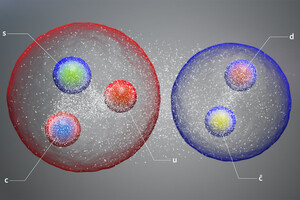opening was made on a large adron collider.

Quarks are elementary particles. They are of six types: lower, upper, strange, enchanted, charming, sincere. Usually they are grouped into groups of two and three, forming adrona (protons and neutrons), of which the nuclei of atoms are composed. But sometimes they form groups of four or five, then tetraquarks and pentaquarks appear.
Read also: Physicists managed to discover a previously unknown particle without using a collider
Scientists predicted the existence of such hadrons about 60 years ago, but it was only during the last two decades that they were discovered. Most of the exotic hadrons discovered in the last two decades are tetraquarks or pentaquarks containing a charmed quark and a charmed antiquark, with the remaining two or three quarks being the top, bottom, or strange quark or their antiquarks.
In 2020, physicists at the Large Hadron Collider discovered a tetraquark consisting of two charmed quarks and two charmed antiquarks, and two open-charm tetraquarks consisting of a charmed antiquark, an up quark, a down quark, and a strange antiquark.
And in 2021, researchers found the first-ever instance of a “double open charm” tetraquark with two charmed quarks and a top and bottom antiquark.
Now scientists using the Large Hadron Collider have discovered a strange pentaquark consisting of a charmed quark and a charmed antiquark, as well as up, down and strange quarks. It is the first pentaquark to contain a strange quark.
An open charm tetraquark has also been discovered, consisting of a charmed quark, a strange antiquark, an up and down antiquark, and its neutral counterpart.
“The more analyzes we do, the more types of exotic hadrons we see. We are witnessing a period of discovery similar to the 1950s when the “zoo of particles” began to be discovered, eventually leading to the quark model of ordinary hadrons in the 1960s. We are creating a “zoo of particles 2.0”, – said one of the authors of the study, Niels Tuning.
The Large Hadron Collider, abbreviated LHC, is an accelerator of charged particles on opposing beams, designed to accelerate protons and heavy ions and study the products of their collisions . The collider is built at CERN (European Council for Nuclear Research), which is located near Geneva, on the border of Switzerland and France. VAK is the largest experimental facility in the world. Its diameter is about 27 km.




